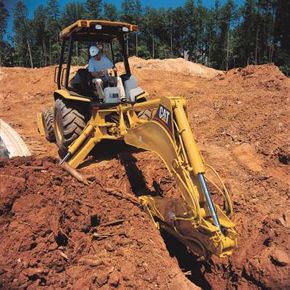Hydraulic Power
If you've ever watched a backhoe at work, you know that it is an extraordinarily powerful tool. An experienced operator can dig a 5-foot-deep, 10-foot-long ditch in less than 15 minutes. Just think how long it would take you to do that with only a shovel! Amazingly, all of this work is done withhydraulics-- pumping liquid to move pistons.
The concept ofhydraulic machinerymay seem pretty bizarre -- how can pumping liquid give you such power? -- but it's actually very simple. First, let's look at the basic idea of a hydraulic system, and then we'll see how a backhoe uses these systems to dig and load such huge amounts of dirt.
Advertisement
Hydraulic systems simply transmitforcesfrom point to point through fluid. Most systems use anincompressiblefluid, a fluid that is as dense as it can get. This sort of fluid transmits nearly all of the original force instead of absorbing some of it. The most commonly used incompressible fluid in hydraulic machinery isoil.
In a very simple hydraulic machine, the operator pushes on the oil with one piston so that the oil pushes on another piston, raising it up.
Hydraulic multiplication
Because the second piston has a largerdiameterthan the first piston, the second piston moves a shorter distance but pushes up with greater force.
The basic concept at work is a trade between distance and force. The work you do in pressing down on the piston on the left has two components -- theamount of forceyou apply andhow faryou push the piston. This pushes down a certain amount of fluid. Since the fluid is incompressible, it can't absorb the force you apply, so it pushes up on the piston on the right. The fluid has the samepressure(pounds per square inch) at every point in the system. Since the pressure at the piston on the right is working on a larger area, that piston pushes upward with a greater force.
It's pretty easy to figure out the exactmultiplication factor. Assume that the piston on the left has a 2-inch diameter (1-inch radius), while the piston on the right has a 6-inch diameter (3-inch radius). The area of each piston isPi * r2. The area of the left piston is therefore 3.14 (3.14 * 12), while the area of the piston on the right is 28.26 (3.14 x 32). The piston on the right is nine times larger than the piston on the left. This means that any force applied to the left-hand piston will be nine times greater on the right-hand piston. So, in the illustration above, the 100-pound downward force applied to the left piston creates a 900-pound upward force on the right piston. But, in keeping with the force-distance trade-off, you've moved the left-hand piston 9 inches and raised the right-hand piston only 1 inch.
在上面所示的滑移式装载机,液压18新利最新登入ystem pumps oil at up to 3,300 pounds per square inch, and the cylinder pistons in the backhoe arm have a diameter of up to 5.25 inches. This gives each cylinder piston a force of 70,000 pounds!



